Offset Printing
20 years of reunification for presses from Plauen

Friday 04. December 2009 - manrolands Plamag plant a success story in the Vogtland region
Printing presses made in Plauen. This describes products that have been successfully established on the global market for more than 100 years. From 1946 to 1989, the manroland AG Plamag Plauen plant mainly delivered its presses to Eastern Bloc nations, today it once more exports to the entire world as it did in its beginnings in 1896.
What has happened since the reunification and what took place within the factory itself? In the spring of 1990, Plamag found a strong business partner in the company then known as MAN Roland Druckmaschinen AG, which enabled it to make the transition to the free market economy within a very short period of time. At the drupa fair in 1990, following several preliminary talks, representatives of both companies signed a declaration of intent regarding future close cooperation and a planned merger in line with anti-trust laws. In the fall of 1990, the German Federal Cartel Office approved the application of MAN Roland to acquire a majority interest in Plamag Plauener Maschinenbau AG. The purchase of the trust institution took place retroactively as of July 1, 1990, upon which the Federal Ministry of Finance approved the purchase contract. The new wholly owned subsidiary was given the name MAN Plamag Druckmaschinen AG.
During the transition period, a great amount of expertise was transferred back and forth between Plauen and Augsburg. The first phase of the agreed on graduated transition process focused on setting up communication channels. The next phase involved an extensive exchange of experience. On a regular basis, Plauen and Augsburg employees held meetings on topics like sales, design, production, electrical systems, electronics and shipping, as well as marketing and human resources. Many Plamag employees worked for days, weeks, and even months at various departments in Augsburg to learn the methods applied there and to subsequently implement them at home. At the same time, specialists from Augsburg repeatedly visited Plauen to support the integration of functions, especially in administration areas.
Improvisation was needed
During the first year after the merger, a great amount of improvisation continued to be needed on both sides to initiate this change on all operational levels. Gradually, the exchange of experience moved from the central functions of design and production to other areas and departments. Numerous project teams constituted the core of an increasingly planned and targeted development process. Employees from the Offenbach product division and the former Augsburg-based affiliated company MAN Diesel were also included in these project teams.
New perspectives for press construction
The close cooperation offered both sides interesting perspectives for extending and marketing both product ranges. Plamag assumed responsibility for expanding the web offset press range in the four- and eight-page sector. The UNISET eight-page series was the first joint project. Design and sales staff from both companies worked together to develop a flexible product system that meets commonly defined technical specifications and that covers the global graphics market for this segment. This first established the image of the firm as a hybrid pioneer.
Developmental milestones in the years 1996 to 1998 included the market launch of the further developed products UNISET with 70,000 and CROMOMAN with 50,000 copies per hour, both featuring shaftless individual motor drives, as well as the double-width eight-page series REGIOMAN at the IPEX in 1998. The most obvious evidence of the speed of this transition was receiving quality management certification according to DIN EN ISO 9001 in March 1995. In mid-2001, MAN Plamag Druckmaschinen AG merged with MAN Roland Druckmaschinen AG. The long-serving chairman of the executive board, Dietrich Hartmann, retired and Georg Riescher, a native of the German Allgaeu region, has been in charge of the plant since that time as Managing Director.
What about today?
Since 1990, more than 750 printing systems have been exported from Plauen to all corners of the world – which is more systems delivered in 19 years than during the entire previous 40 years in the former German Democratic Republic. The presses are larger, more complex, and all offer four-color printing. Today, media companies from Iceland to South Africa and from Hawaii via India to New Zealand rely on the tested quality of the Plauen company, which was renamed manroland in May 2008.
